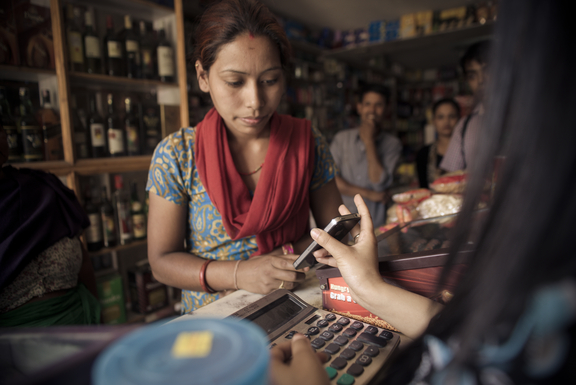New technology has become central to relief efforts in humanitarian crises. This may make relief efforts more effective, but we can’t assume that the technology will have only a beneficial impact on the recipients of emergency aid.

Testing a new system of emergency assistance in Nepal. Recipients receive virtual vouchers via SMS message on mobile phones that can be used like cash at participating local stores. Photo: Suraj Shakya for Mercy Corps.
Today, mobile phones, social media, crisis mapping, online volunteering, and pre-paid cards are changing how humanitarian crises are identified, analysed and addressed – and, not least, who the humanitarian responder is. Information technology has become an integral part of crisis response operations: in the wake of Typhoon Yolanda in the Philippines in November 2013, re-establishing internet access was the top priority for humanitarian organisations.
Virtual disaster relief?
Technology can give more voice to the beneficiaries of emergency aid. Victims of catastrophic events are increasingly able to assist in their own rescue: people trapped under rubble in Haiti sent text messages explaining their location. Volunteers around the world worked with the Haitian diaspora to plot these text messages onto crisis maps. These maps could then be used by relief workers on the ground.
Emergency aid is also being distributed in new ways. The distribution of pre-paid cards or SMS voucher codes that can be exchanged for groceries at ordinary shops are becoming increasingly common. The World Food Programme (WFP) and MasterCard are collaborating on a “digital food” project. The WFP aims to distribute one third of its aid this way before the end of 2015.
Access to information is increasingly seen as an important form of humanitarian emergency relief. The basic idea is that people who have access to information about the situation they find themselves in and about their rights are able to make better choices.
New technology can help deliver more knowledge-based, effective and responsible humanitarian aid. At the same time, information about natural disasters and conflicts is shaped by the context in which the crisis arises. Accordingly this information can and will be used to achieve political ends. Neither individual data fragments, larger data sets, nor the technology used for gathering data are neutral.
In cases where the security of humanitarian workers is coming increasingly under threat, technology may make it possible to maintain at least a partial presence. However, remote management may also reduce the humanitarian organisations’ capacity to understand actual needs on the ground. Remote management can also be self-reinforcing, and legitimise so-called “bunkerisation”, where international relief workers increasingly manage aid operations behind walled compounds, sending local employees to the field.
Data gathering vs personal data protection?
Access to information and ways of gathering data are rapidly increasing, without the commensurate attention to how the consent of victims of war and natural disasters can be ensured. Large-scale data gathering can make humanitarian assistance more effective, but responsible data gathering requires the completion of risk analyses, obtaining the consent when gathering personal and sensitive information, and measures to ensure that the information remains secure. Time and resources are very limited in crisis situations. It is reasonable to expect that the need to provide assistance quickly will take priority. In addition, issues concerning data protection and the right to privacy are often seen as a Western ‘luxury problem’, supposedly with little relevance for people affected by humanitarian crises.
In the case of conflict, information about the recipients of emergency aid may include sensitive details about ongoing violence- or rumours about such violence. In fact: Data security becomes a matter of life and death if the data can be used to identify a person who reported an illegal act or attack. If data falls into the wrong hands, it may have fatal consequences for the people concerned. Unfortunately procedures for storing and sharing such information are still being developed among many of the organisations responsible for data gathering.
2016 international humanitarian summit
In 2016, OCHA, the UN body responsible for coordinating emergency response efforts, will be hosting the World Humanitarian Summit in Istanbul. A central item on the agenda will be the possibilities offered by technology for disaster relief. However, there is so far insufficient understanding of the challenges associated with these technologies. Norway, with its strong commitment to humanitarian work through the UN and voluntary organisations, is in a position to influence this agenda.
There are three areas in particular on which Norway should focus its efforts:
- First, the development of data management systems that are specially adapted for use in crisis situations is a central need, including satisfactory measures for data security and the obtaining of consents as fundamental requirements. When time is short, this will help balance the competing priorities of providing rapid and effective assistance and a secure data management.
- Second, the reciprocal understanding of what is at stake in this new collaboration between humanitarians and software developers must be improved.
- Third, the overarching objective should be for new technology to improve knowledge about needs on the ground, allowing a better customisation of the emergency relief that is being provided.
* The authors of this article have edited a feature on humanitarian technology in the latest edition of the Norwegian journal Internasjonal Politikk.
A short version of this post was published in Norwegian in the daily newspaper Dagens Næringsliv 24 July.
Translation from Norwegian: Fidotext